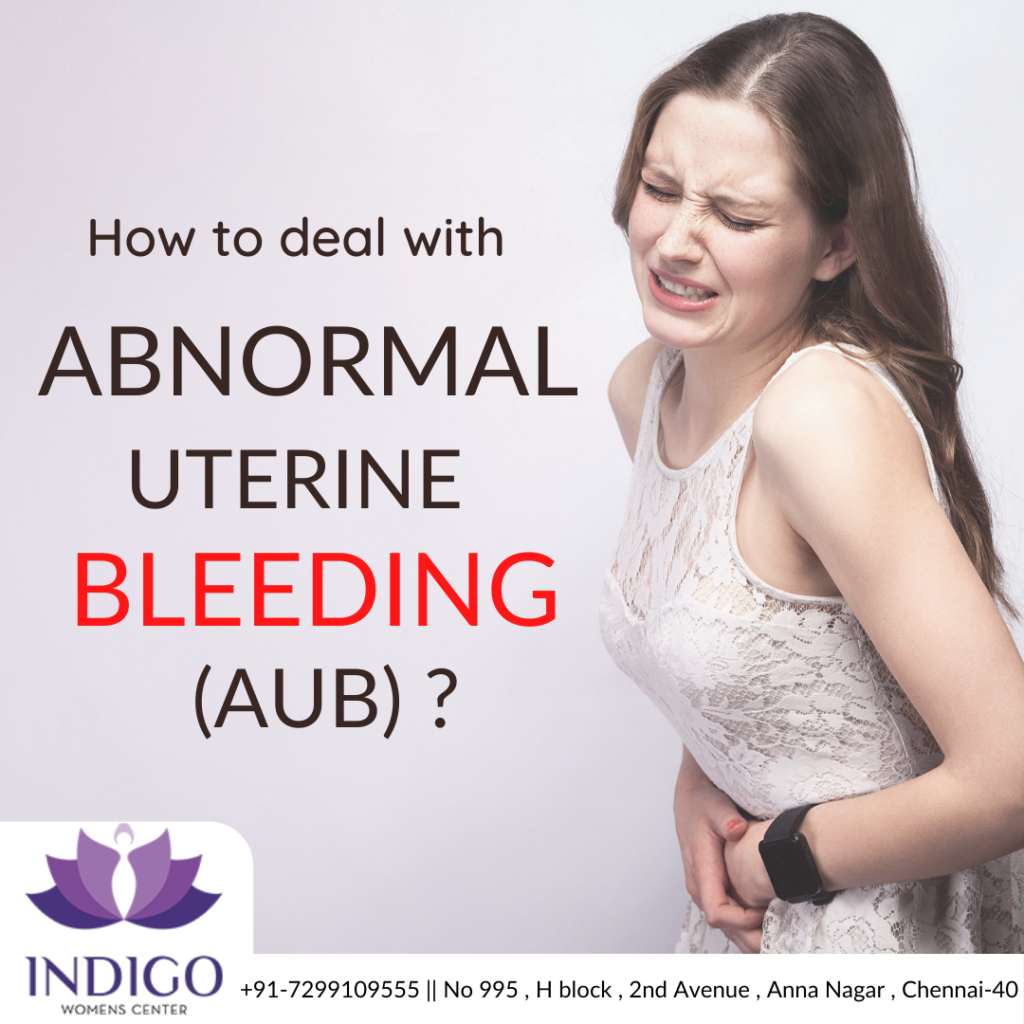Abnormal uterine bleeding (AUB) is a broad term that describes irregularities in the menstrual cycle involving frequency, regularity, duration, and volume of flow outside of pregnancy. Up to one-third of women will experience abnormal uterine bleeding in their life, with irregularities most commonly occurring at menarche and perimenopause.
A normal menstrual cycle has a frequency of 24 to 38 days, lasts 7 to 9 days, with 5 to 80 milliliters of blood loss. Variations in any of these 4 parameters constitute abnormal uterine bleeding. Older terms such as oligomenorrhea, menorrhagia, and dysfunctional uterine bleeding should be discarded in favor of using simple terms to describe the nature of the abnormal uterine bleeding. Revisions to the terminology were first published in 2007, followed by updates from the International Federation of Obstetrics and Gynecology (FIGO) in 2011 and 2018. The FIGO systems first define the abnormal uterine bleeding, then give an acronym for common etiologies. These descriptions apply to chronic, nongestational AUB.
Abnormal uterine bleeding can also be divided into acute versus chronic. Acute AUB is excessive bleeding which requires immediate intervention to prevent further blood loss. Acute AUB can occur on its own or superimposed on chronic AUB, which refers to irregularities in menstrual bleeding for most of the previous 6 months.
The N stands for “not otherwise classified”.
• P: Polyp
• A: Adenomyosis
• L: Leiomyoma
• M: Malignancy and hyperplasia
• C: Coagulopathy
• O: Ovulatory dysfunction
• E: Endometrial disorders
• I:- Iatrogenic
• N: Not otherwise classified
One or more of the problems listed above can contribute to a patient’s abnormal uterine bleeding. Some structural entities, such as endocervical polyps, endometrial polyps, or leiomyomas, may be asymptomatic and not the primary cause of a patient’s AUB.
In the 2018 FIGO system, AUB secondary to anticoagulants was moved from the coagulopathy category to the iatrogenic category. AUB not otherwise classified contains etiologies that are rare, and include arteriovenous malformations (AVMs), myometrial hyperplasia, and endometritis.
The uterine and ovarian arteries supply blood to the uterus. These arteries become the arcuate arteries; then the arcuate arteries send off radial branches which supply blood to the 2 layers of the endometrium, the functionalis, and basalis layers. Progesterone levels fall at the end of the menstrual cycle, leading to enzyme breakdown of the functionalis layer of the endometrium. This breakdown leads to blood loss and sloughing which makes up menstruation. Functioning platelets and thrombin, and vasoconstriction of the arteries to the endometrium control blood loss. Any derangement in the structure of the uterus (such as leiomyoma, polyps, adenomyosis, malignancy or hyperplasia), derangements to the clotting pathways (coagulopathies or iatrogenically), or disruption of the hypothalamic-pituitary-ovarian axis (through ovulatory/endocrine disorders or iatrogenically) can affect menstruation and lead to abnormal uterine bleeding.
The uterine and ovarian arteries supply blood to the uterus. These arteries become the arcuate arteries; then the arcuate arteries send off radial branches which supply blood to the 2 layers of the endometrium, the functionalis, and basalis layers. Progesterone levels fall at the end of the menstrual cycle, leading to enzyme breakdown of the functionalis layer of the endometrium. This breakdown leads to blood loss and sloughing which makes up menstruation. Functioning platelets and thrombin, and vasoconstriction of the arteries to the endometrium control blood loss. Any derangement in the structure of the uterus (such as leiomyoma, polyps, adenomyosis, malignancy or hyperplasia), derangements to the clotting pathways (coagulopathies or iatrogenically), or disruption of the hypothalamic-pituitary-ovarian axis (through ovulatory/endocrine disorders or iatrogenically) can affect menstruation and lead to abnormal uterine bleeding.
History and Physical Examination
The clinician should obtain a detailed history from a patient who presented with complaints related to menstruation.
• Menstrual history
• Age at menarche
• Last menstrual period
• Menses frequency, regularity, duration, volume of flow
• Frequency can be described as frequent (less than 24 days), normal (24 to 38 days), or infrequent (greater than 38 days)
• Regularity can be described as absent, regular (with a variation of +/- 2 to 20 days), or irregular
• Duration can be described as prolonged (greater than 8 days), normal (approximately 4 to 8 days), or shortened (less than 4 days)
• Volume of flow can be described as heavy (greater than 80 mL), normal (5 to 80 mL), or light (less than 5 mL of blood loss)
• Exact volume measurements are difficult to determine outside research settings; therefore, detailed questions regarding frequency of sanitary product changes during each day, passage and size of any clots, need to change sanitary products during the night, and a “flooding” sensation are important
• Intermenstrual and postcoital bleeding
• Sexual and reproductive history
• Obstetrical history including the number of pregnancies and mode of delivery
• Fertility desire and subfertility
• Current contraception
• History of sexually transmitted infections (STIs)
• PAP smear history
• Associated symptoms/Systemic symptoms
• Weight loss
• Pain
• Discharge
• Bowel or bladder symptoms
• Signs/symptoms of anemia
• Signs/symptoms or history of a bleeding disorder
• Signs/symptoms or history of endocrine disorders
• Current medications
• Family history, including questions concerning coagulopathies, malignancy, endocrine disorders
• Social history, including tobacco, alcohol, and drug uses; occupation; impact of symptoms on quality of life
• Surgical history
The physical exam should include:
• Vital signs, including blood pressure and body mass index (BMI)
•Signs of pallor, such as skin or mucosal pallor
• Signs of endocrine disorders
• Examination of the thyroid for enlargement or tenderness
• Excessive or abnormal hair growth patterns, clitoromegaly, acne that could indicate hyperandrogenism
• Moon facies, abnormal fat distribution, striae that could indicate Cushing’s
• Signs of coagulopathies, such as bruising or petechiae
• Abdominal exam to palpate for any pelvic or abdominal masses
• Pelvic exam: Speculum and bimanual
• PAP smear if indicated
• STI screening (such as for gonorrhea and chlamydia) and wet prep if indicated
• Endometrial biopsy, if indicated
Evaluation
Laboratory testing can include but is not limited to a urine pregnancy test, complete blood count, ferritin, coagulation panel, thyroid function tests, gonadotropins, prolactin.
Imaging studies can include transvaginal ultrasound, MRI, hysteroscopy. Transvaginal ultrasound does not expose the patient to radiation and can show uterus size and shape, leiomyomas (fibroids), adenomyosis, endometrial thickness, and ovarian anomalies. It is an important tool and should be obtained early in the investigation of abnormal uterine bleeding. MRI provides detailed images that may be useful in surgical planning, but it is costly and not the first line choice for imaging in patients with AUB. Hysteroscopy and sonohysterography (transvaginal ultrasound with intrauterine contrast) are helpful in situations where endometrial polyps are noted, images from transvaginal ultrasound are inconclusive, or submucosal leiomyomas are seen. Hysteroscopy and sonohysterography are more invasive, but can often be performed in office settings.
Endometrial tissue sampling may not be necessary for all women with AUB but should be performed on women at high risk for hyperplasia or malignancy. An endometrial biopsy is considered the first-line test in women with AUB who are 45 years or older. Endometrial sampling should also be performed in women younger than 45 with unopposed estrogen exposure, such as women with obesity and/or polycystic ovarian syndrome (PCOS), as well as a failure of treatment, or persistent bleeding.
Treatment / Management
Treatment of abnormal uterine bleeding depends on multiple factors, such as the etiology of the AUB, fertility desire, the clinical stability of the patient, and other medical comorbidities. Treatment should be individualized based on these factors. In general, medical options are preferred as initial treatment for AUB.
For acute abnormal uterine bleeding, hormonal methods are first-line in medical management. Intravenous (IV) conjugated equine estrogen, combined oral contraceptive pills (OCPs), and oral progestins are all options for treatment of acute AUB. Tranexamic acid prevents fibrin degradation and can be used to treated acute AUB. Tamponade of the uterine bleeding with a Foley bulb is a mechanical option for treatment of acute AUB. It is important to assess the clinical stability of the patient and replace volume with intravenous fluids and blood products while attempting to stop the acute abnormal uterine bleeding. Desmopressin, administered intranasally, subcutaneously, or intravenously, can be given for acute AUB secondary to the coagulopathy von Willebrand disease.
Based on the PALM-COEIN acronym for etiologies of chronic AUB, specific treatment options for each category are listed below:
Polyps are treated through surgical resection.
Adenomyosis is treated via hysterectomy. Less often, adenomyomectomy is performed.
Leiomyomas (fibroids) can be treated through medical or surgical management depending on the patient’s desire for fertility, medical comorbidities, pressure symptoms, and distortion of the uterine cavity. Surgical options include uterine artery embolization, endometrial ablation, or hysterectomy. Medical management options include a levonorgestrel-releasing intrauterine device (IUD), GnRH agonists, systemic progestins, and tranexamic acid with non-steroidal anti-inflammatory drugs (NSAIDs).
Malignancy or hyperplasia can be treated through surgery, +/- adjuvant treatment depending on the stage, progestins in high doses when surgery is not an option, or palliative therapy, such as radiotherapy.
Coagulopathies leading to AUB can be treated with tranexamic acid or desmopressin (DDAVP).
Ovulatory dysfunction can be treated through lifestyle modification in women with obesity, PCOS, or other conditions in which anovulatory cycles are suspected. Endocrine disorders should be corrected with the use of appropriate medications, such as cabergoline for hyperprolactinemia and levothyroxine for hypothyroidism.
Endometrial disorders have no specific treatment as mechanisms are not clearly understood.
Iatrogenic causes of AUB should be managed based on the offending drug and/or drugs. If a certain method of contraception is the suspected culprit for AUB, alternative methods can be considered, such as the levonorgestrel-releasing IUD, combined oral contraceptive pills (in monthly or extended cycles), or systemic progestins. If other medications are suspected and cannot be discontinued, the aforementioned methods can also be helpful to control AUB. Individual therapy should be tailored based on a patient’s reproductive wishes and medical comorbidities.
Not otherwise classified causes of AUB include entities such as endometritis and AVMs. Endometritis can be treated with antibiotics and AVMs with embolization.





